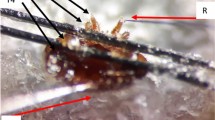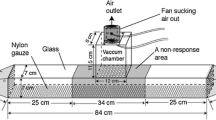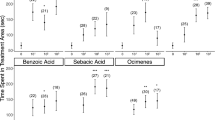Abstract
Detection and interpretation of chemical cues is essential for Varroa destructor Anderson and Trueman, an important parasite of honey bees (Apis mellifera L.), to complete its life cycle. We collected volatiles from honey bee brood at various developmental stages and screened for V. destructor electrophysiological responses to these with gas chromatography-linked electrotarsal detection. Volatile collections contained several methyl-alkanes that evoked electrophysiological responses from V. destructor. Moreover, odors in honey bee colonies that regulate honey bee colony structure and function were also detected by V. destructor. Collections from mid- to late-stage larvae had detectable levels of low-volatility odors identified as components of the honey bee brood pheromone and branched alkanes likely originating from brood cuticle. Among these, several mid- to heavy-molecular weight compounds elicited high proportional electrophysiological responses by V. destructor relative to their abundance but could not be identified using chemical standards of previously documented honey bee brood odors. We suggest further investigation of these unknown volatiles and future behavioral assays to determine attractiveness/repellency (valence) of those identified through chemical standards.



Similar content being viewed by others
References
Beetsma J (1994) The Varroa mite, a devastating parasite of western honeybees and an economic threat to beekeeping. Outlook Agric 23:169–175
Bissinger BW, Roe RM (2010) Tick repellents: past, present, and future. Pestic Biochem Physiol 96:63–79
Blum MS (1996) Semiochemical parsimony in the Arthropoda. Annu Rev Entomol 41:353–374
Boot WJ, Beetsma J, Calis JNM (1994) Behaviour of Varroa mites invading honey bee brood cells. Exp Appl Acarol 18:371–379
Boot WJ, Driessen RG, Calis JNM, Beetsma J (1995) Further observations on the correlation between attractiveness of honey bee brood cells to Varroa jacobsoni and the distance from larva to cell rim. Entomol Exp Appl 76:223–232
Carr AL, Roe M (2016) Acarine attractants: chemoreception, bioassay, chemistry and control. Pestic Biochem Physiol 131:60–79
Carroll MJ, Duehl AJ (2012) Collection of volatiles from honeybee larvae and adults enclosed on brood frames. Apidologie 43:715–730
Currie RW, Pernal SF, Guzmán-Novoa E (2010) Honey bee colony losses in Canada. J Apic Res 49:104–106
de Bruyne M, Dicke M, Tjallingii WF (1991) Receptor cell responses in the anterior tarsi of Phytoseiulus persimilis to volatile kairomone components. Exp Appl Acarol 13:53–58
Dietemann V, Nazzi F, Martin SJ, Anderson DL, Locke B, Delaplane KS, Wauquiez Q, Tannahill C, Frey E, Ziegelmann B, Rosenkranz P, Ellis JD (2013) Standard methods for Varroa research. J Apic Res 52:1–54
Dillier F, Guerin P, Fluri P, Imdorf A, Meyre PB, Diehl P, Bee S (2003) Odour-mediated transfer to brood cells of its honeybee host, Apis mellifera, and olfactory cell responses of Varroa destructor to volatiles. Swiss Bee Research Center, Bern, pp 1–14
Donzé G, Schnyder-Candrian S, Bogdanov S, Diehl P-A, Guerin PM, Kilchenman V, Monachon F (1998) Aliphatic alcohols and aldehydes of the honey bee cocoon induce arrestment behavior in Varroa jacobsoni (Acari: Mesostigmata), an ectoparasite of Apis mellifera. Arch Insect Biochem 37:129–145
Drijfhout FP, Kochansky J, Lin S, Calderone NW (2005) Components of honeybee royal jelly as deterrents of the parasitic Varroa mite, Varroa destructor. J Chem Ecol 31:1747–1764
Endris J, Baker R (1993) Action potentials recorded from the foreleg of Varroa jacobsoni after olfactory stimulation. Apidologie 24:488–489
Frey E, Odemer R, Blum T, Rosenkranz P (2013) Activation and interruption of the reproduction of Varroa destructor is triggered by host signals (Apis mellifera). J Invertebr Pathol 113:56–62
Gilley DC, DeGrandi-Hoffman G, Hooper JE (2006) Volatile compounds emitted by live European honey bee (Apis mellifera L.) queens. J Insect Physiol 52:520–527
Grozinger CM, Fischer P, Hampton JE (2007) Uncoupling primer and releaser responses to pheromone in honey bees. Naturwissenschaften 94:375–379
Human H, Brodschneider R, Dietemann V, Dively G, Ellis JD, Forsgren E, Fries I, Hatjina F, Hu F-L, Jaffé R, Jensen AB, Köhler A, Magyar JP, Özkýrým A, Pirk CWW, Rose R, Strauss U, Tanner G, Tarpy DR, van der Steen JJM, Vaudo A, Vejsnæs F, Wilde J, Williams GR, Zheng H-Q (2013) Miscellaneous standard methods for Apis mellifera research. J Apic Res 52:1–53
Kraus B (1994) Factors influencing host choice of the honey bee parasite Varroa jacobsoni Oud. Exp Appl Acarol 18:435–443
Kuenen LPS, Calderone NW (1997) Transfers of Varroa mites from newly emerged bees: preferences for age- and function-specific adult bees (Hymenoptera: Apidae). J Insect Behav 10:213–228
Kunert M, David A, Becher J, Boland W (2009) Volatile sampling from biological sources by the closed-loop-stripping technique. Cold Spring Harb Protoc 4:1–8
Le Conte Y, Arnold G (1987) Influence de l’âge des abeilles (Apis mellifera L.) et de la chaleur sur le comportement de Varroa jacobsoni Oud. Apidologie 18:305–320
Le Conte Y, Arnold G, Trouiller J, Masson C, Chappe B, Ourisson G (1989) Attraction of the parasitic mite Varroa to the drone larvae of honey bees by simple aliphatic esters. Science 245:638–639
Le Conte Y, Arnold G, Trouiller J, Masson C, Chappe B (1990) Identification of a brood pheromone in honeybees. Naturwissenschaften 77:334–336
Light M, Shutler D, Cutler GC, Hillier NK (2020) Electrotarsogram responses to synthetic odorants by Varroa destructor, a primary parasite of western honey bees (Apis mellifera). Exp Appl Acarol 81(4). https://doi.org/10.1007/s10493-020-00514-1
Lindberg CM, Melathopoulos AP, Winston ML (2000) Laboratory evaluation of miticides to control Varroa jacobsoni (Acari: Varroidae), a honey bee (Hymenoptera: Apidae) parasite. J Econ Entomol 93:189–198
Lis B, Bakuła T, Baranowski M, Czarnewicz A (2011) The carcinogenic effects of benzoquinones produced by the flour beetle. Pol J Vet Sci 14:159–164
Ma R, Villar G, Grozinger CM, Rangel J (2018) Larval pheromones act as colony-wide regulators of collective foraging behavior in honeybees. Behav Ecol 29:1132–1141
Maisonnasse A, Lenoir J-C, Costagliola G, Beslay D, Choteau F, Crauser D, Becard J-M, Plettner E, Le Conte Y (2009) A scientific note on E-β-ocimene, a new volatile primer pheromone that inhibits worker ovary development in honey bees. Apidologie 40:562–564
Martin SJ, Kemp D (1997) Average number of reproductive cycles performed by Varroa jacobsoni in honey bee (Apis mellifera) colonies. J Apic Res 36:113–123
Martin SJ, Provost E, Bagnères AG, Roux M, Clément JL, Le Conte Y (2002) Potential mechanism for detection by Apis mellifera of the parasitic mite Varroa destructor inside sealed brood cells. Physiol Entomol 27:175–188
McAfee A, Collins TF, Madilao LL, Foster LJ (2017) Odorant cues linked to social immunity induce lateralized antenna stimulation in honey bees (Apis mellifera L.). Sci Rep 7:46171
McCormick AC, Gershenzon J, Unsicker SB (2014) Little peaks with big effects: establishing the role of minor plant volatiles in plant-insect interactions. Plant, Cell Environ 37:1836–1844
Milani N (1999) The resistance of Varroa jacobsoni Oud. to acaricides. Apidologie 30:229–234
Miller TA, Lampe DJ, Lauzon CR (2007) Insecticides design using advanced technologies. Springer-Verlag, Berlin
Molnár BP, Tóth Z, Fejes-Tóth A, Dekker T, Kárpáti Z (2015) Electrophysiologically-active maize volatiles attract gravid female European corn borer, Ostrinia nubilalis. J Chem Ecol 41:997–1005
Nazzi F, Le Conte Y (2016) Ecology of Varroa destructor, the major ectoparasite of the western honey bee, Apis mellifera. Annu Rev Entomol 61:417–432
Nazzi F, Milani N, Della Vedova G (2004) A semiochemical from larval food influences the entrance of Varroa destructor into brood cells. Apidologie 35:403–410
Nazzi F, Bortolomeazzi R, Della Vedova G, Del Piccolo F, Annoscia D, Milani N (2009) Octanoic acid confers to royal jelly Varroa-repellent properties. Naturwissenschaften 96:309–314
Nieva-Echevarría B, Manzanos MJ, Goicoechea E, Guillén MD (2015) 2,6-Di-tert-butyl-hydroxytoluene and its metabolites in foods. Compr Rev Food Sci Food Saf 14:67–80
Nilius B, Appendino G, Owsianik G (2012) The transient receptor potential channel TRPA1: from gene to pathophysiology. Pflügers Arch J Physiol 464:425–458
Pankiw T, Page RE (2001) Brood pheromone modulates honeybee (Apis mellifera L.) sucrose response thresholds. Behav Ecol Sociobiol 49:206–213
Peng G, Kashio M, Morimoto T, Li T, Zhu J, Tominaga M, Kadowaki T (2015) Plant-derived tick repellents activate the honey bee ectoparasitic mite TRPA1. Cell Rep 12:190–202
Pernal SF, Baird DS, Birmingham AL, Higo HA, Slessor KN, Winston ML (2005) Semiochemicals influencing the host-finding behaviour of Varroa destructor. Exp Appl Acarol 37:1–26
Plettner E, Eliash N, Singh NK, Pinnelli GR, Soroker V (2017) The chemical ecology of host-parasite interaction as a target of Varroa destructor control agents. Apidologie 48:78–92
Popova M, Reyes M, Le Conte Y, Bankova V (2014) Propolis chemical composition and honeybee resistance against Varroa destructor. Nat Prod Res 28:788–794
Raguso RA, Pellmyr O (1998) Dynamic headspace analysis of floral volatiles: a comparison of methods. Oikos 81:238
R Core Team (2018) R: a language and environment for statistical computing. Foundation for Statistical Computing, Vienna, Austria
Rosenkranz P, Aumeier P, Ziegelmann B (2010) Biology and control of Varroa destructor. J Invertebr Pathol 103:S96–S119
Stein SE, Mikaia A, White E, Zaikin V, Zhu D, Sparkman OD, Neta P, Babushok V, Zenkevich I, Linstrom P, Mirokhin P, Tchekhovskoi D, Yang X, Mallard WG, Sparkman JA (2011) NIST Standard Reference Database 1A—User’s Guide. 1–65.
Thom C, Gilley DC, Hooper J, Esch HE (2007) The scent of the waggle dance. PLoS Biol 5:1862–1867
Torto B, Arbogast RT, Alborn H, Suazo A, Van Engelsdorp D, Boucias D, Tumlinson JH, Teal PEA (2007) Composition of volatiles from fermenting pollen dough and attractiveness to the small hive beetle Aethina tumida, a parasite of the honeybee Apis mellifera. Apidologie 38:380–389
Torto B, Carroll MJ, Duehl A, Fombong AT, Gozansky TK, Nazzi F, Soroker V, Teal PEA (2013) Standard methods for chemical ecology research in Apis mellifera. J Apic Res 52:1–34
Trouiller J, Arnold G, Chappe B, Le Conte Y, Masson C (1992) Semiochemical basis of infestation of honey bee brood by Varroa jacobsoni. J Chem Ecol 18:2041–2053
Weldon PJ, Aldrich JR, Klun JA, Oliver JE, Debboun M (2003) Benzoquinones from millipedes deter mosquitoes and elicit self-anointing in capuchin monkeys (Cebus spp.). Naturwissenschaften 90:301–304
Yoder JA, Sammataro D (2003) Potential to control Varroa mites (Acari: Varroidae) using chemical ecology. Int J Acarol 29:139–143
Ziegelmann B, Tolasch T, Steidle JLM, Rosenkranz P (2013) The mating behavior of Varroa destructor is triggered by a female sex pheromone. Part 2: identification and dose-dependent effects of components of the Varroa sex pheromone. Apidologie 44:481–490
Acknowledgements
The authors thank A. Collins, D. Kristie, N. Faraone, P. Brandt, and K. Spicer and the INSECTA lab at Acadia University for various forms of assistance. Also, we thank the reviewers for their commitment to editing and commenting on this manuscript. We thank the Atlantic Canada Opportunities Agency Atlantic Innovation Fund (#197853), Canada Foundation for Innovation (22087), Natural Sciences and Engineering Research Council of Canada (RGPIN-2017-04319) and Project Apis m. for providing research funding and resources.
Author information
Authors and Affiliations
Corresponding author
Additional information
Publisher's Note
Springer Nature remains neutral with regard to jurisdictional claims in published maps and institutional affiliations.
Electronic supplementary material
Below is the link to the electronic supplementary material.
Rights and permissions
About this article
Cite this article
Light, M., Shutler, D., Cutler, G.C. et al. Varroa destructor mite electrophysiological responses to honey bee (Apis mellifera) colony volatiles. Exp Appl Acarol 81, 495–514 (2020). https://doi.org/10.1007/s10493-020-00519-w
Received:
Accepted:
Published:
Issue Date:
DOI: https://doi.org/10.1007/s10493-020-00519-w




